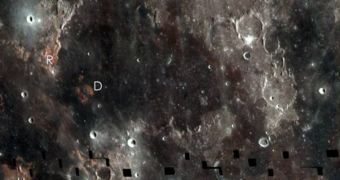On Friday, October 7, scientists Mark Robinson and Brett Denevi held a presentation at the joint meeting of the European Planetary Science Congress and the American Astronomical Society’s Division for Planetary Sciences, revealing the presence of vast titanium deposits on the Moon.
The discovery was made using new data collected by the NASA Lunar Reconnaissance Orbiter (LRO), a spacecraft deployed in lunar orbit to map the surface of Earth's only natural satellite. Information obtained by the probe will be of great use for future manned missions to the Moon.
In the most recent study, investigators combined visible-light and ultraviolet observations to reveal the presence of this important chemical in the lunar crust. In addition to its commercial value, the mineral will also come in handy for developing new theories on how the Moon's interior looks like.
The LRO Camera (LROC) Wide Angle Camera (WAC) was the main instrument researchers at the Arizona State University (ASU) used for their latest study. The tool is capable of capturing images in seven different wavelength bands simultaneously.
The instrument is capable of providing a resolution level of 100 to 400 meters (328 to 1,312 feet) per pixel, which is sensitive enough for this type of applications. For comparison, the HiRISE instrument on the Mars Reconnaissance Orbiter has a resolution of 0.3 meters (1 foot) per pixel.
“Looking up at the Moon, its surface appears painted with shades of grey – at least to the human eye. But with the right instruments, the Moon can appear colorful,” explained Robinson, who holds an appointment at ASU.
“The maria appear reddish in some places and blue in others. Although subtle, these color variations tell us important things about the chemistry and evolution of the lunar surface. They indicate the titanium and iron abundance, as well as the maturity of a lunar soil,” he added, quoted by Europlanet.
The team created a complex mosaic image containing more than 4,000 LRO WAC photos, which the LRO collected over the course of a month. They used special research techniques to analyze the brightness of the surface, and then compared the data to info gathered by the Apollo and Luna missions.
“We still don’t really understand why we find much higher abundances of titanium on the Moon compared to similar types of rocks on Earth,” Robinson said at the meeting.
“What the lunar titanium-richness does tell us is that the interior of the Moon had less oxygen when it was formed, knowledge that geochemists value for understanding the evolution of the Moon,” he concluded.

 14 DAY TRIAL //
14 DAY TRIAL //